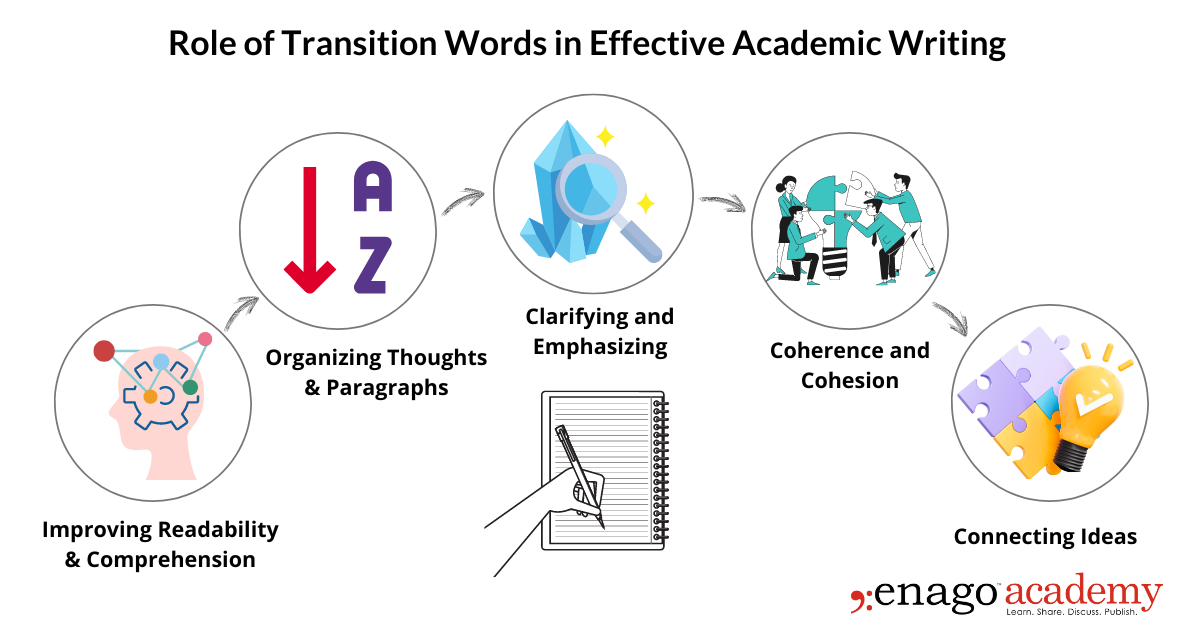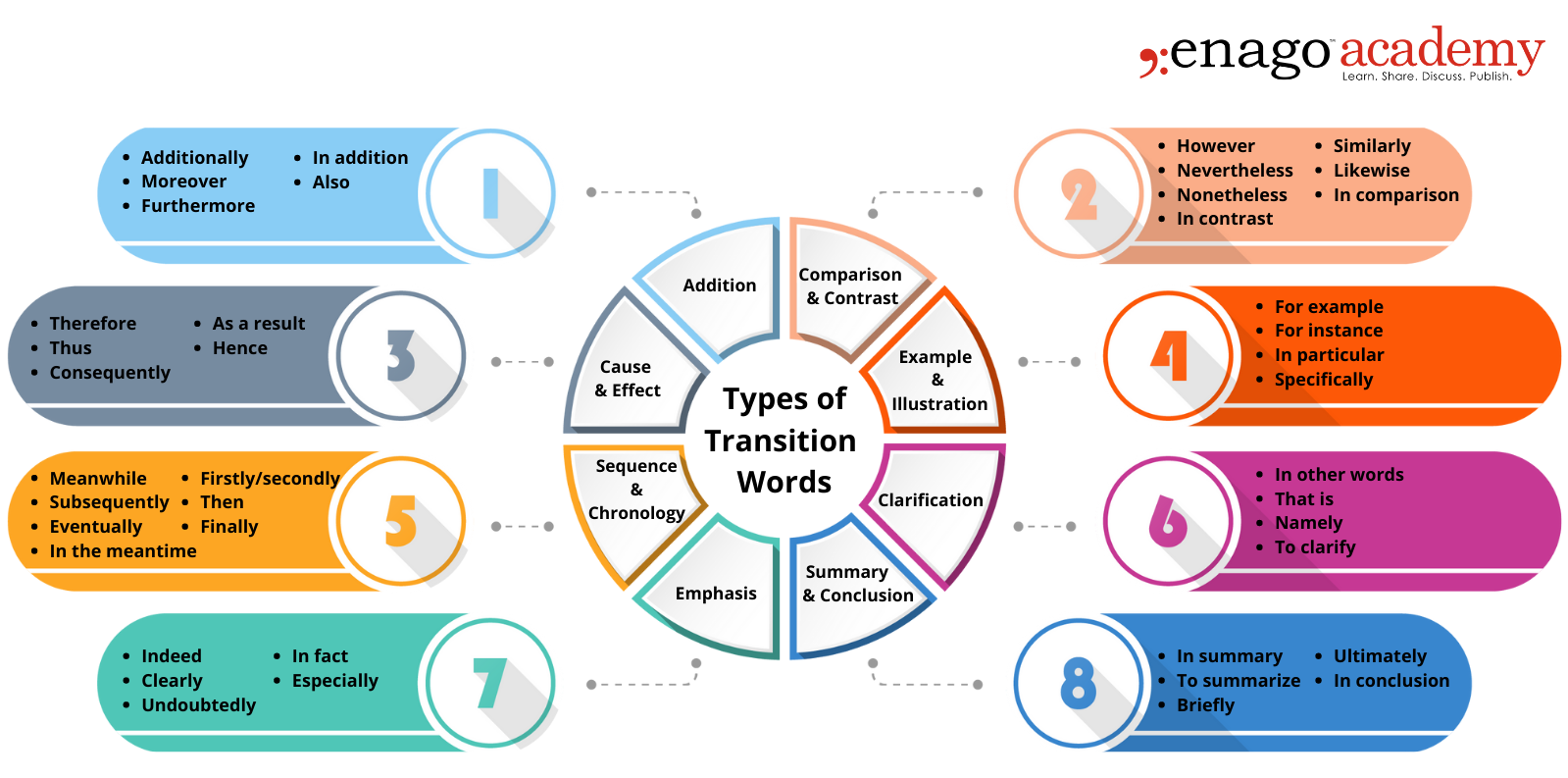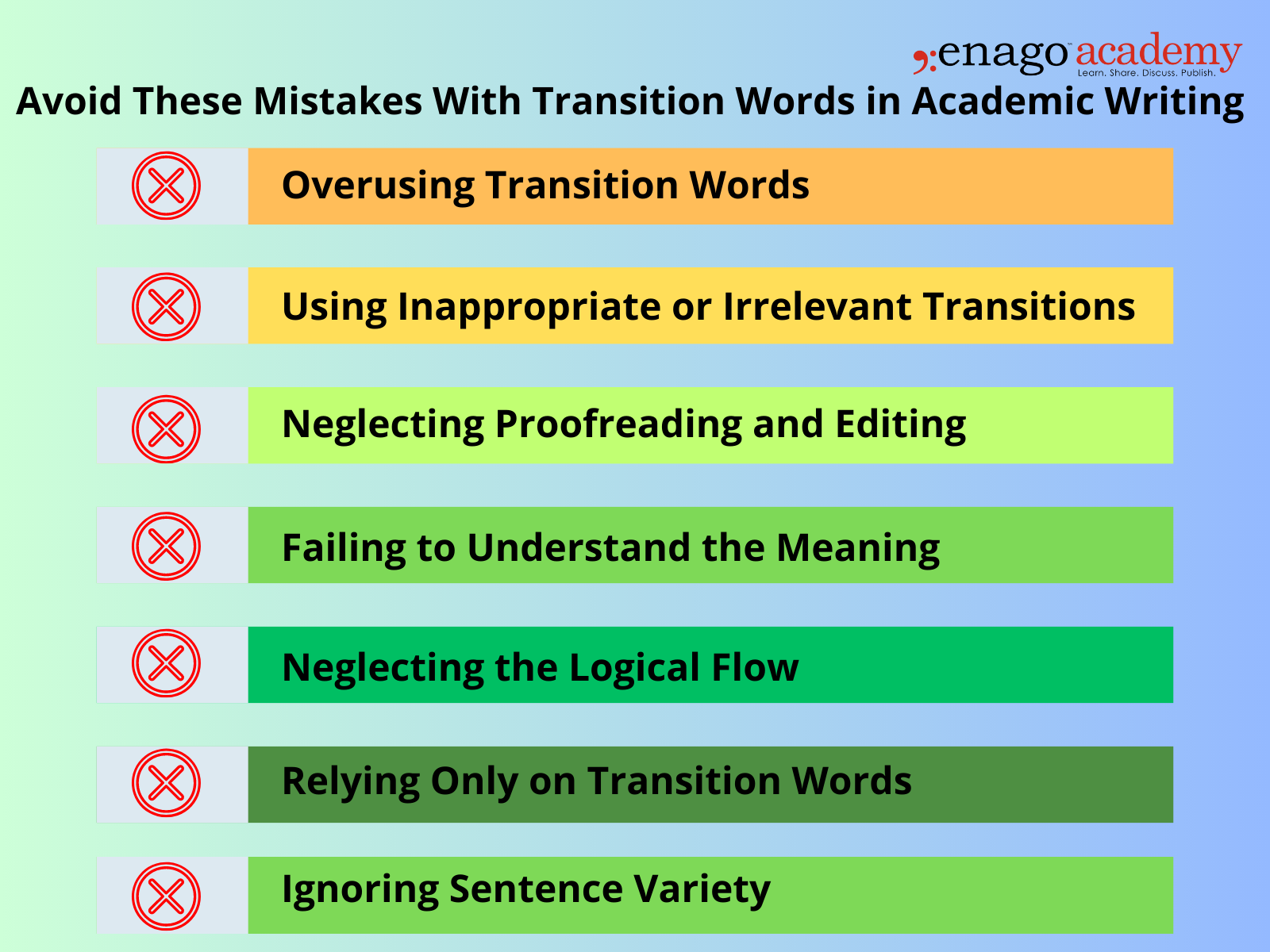The Power of Transition Words: How they connect and clarify your academic writing

Academic writing demands clear communication of ideas to facilitate the exchange of knowledge, and to ensure that information is conveyed accurately and comprehensively. It serves as a vehicle for critical thinking, analysis, and synthesis, allowing scholars to contribute meaningfully to their fields of study. By employing suitable analogies and metaphors, writers can better understand the significance of their craft and strive to hone their skills in order to contribute meaningfully to the academic community. Let’s understand how we can achieve excellence in academic writing by using transition words.
What Are Transition Words?
Transition words are words or phrases that help establish connections between sentences, paragraphs, or ideas in a piece of writing. They act as bridges, guiding readers through the logical flow of information and signalling relationships between different parts of the text. Furthermore, they provide coherence and cohesion to your writing by clarifying the relationships between ideas, adding structure, and improving the overall readability.
Download this FREE infographic and make appropriate use of every transition word to enhance your academic writing.
Role of Transition Words in Effective Academic Writing
Transition words play a crucial role in enhancing clarity and coherence in academic writing. They act as linguistic signposts that guide readers through the text, helping them understand the relationships between ideas, and ensuring a smooth flow of information. The primary roles of these words in enhancing clarity and coherence can be summarized as follows:
A. Improving Readability and Comprehension
By facilitating smooth transitions and organizing information effectively, these words enhance the readability and comprehension of academic writing. They help readers navigate through complex texts, understand complex ideas, and follow the structure of the argument. Transition words facilitate reader navigation and comprehension, enhancing the reading experience with increased engagement and accessibility.
B. Organizing Thoughts and Paragraphs
Transition words assist in organizing thoughts and structuring the content of an academic paper. They provide a framework for presenting ideas in a coherent and systematic manner. By indicating sequence, order, or cause and effect relationships, these words help writers create a logical flow that guides readers smoothly from one point to the next. They enable the construction of well-organized paragraphs and facilitate the development of cohesive arguments.
C. Clarifying and Emphasizing
Transition words contribute to the clarity and precision of academic writing. They help define terms, rephrase or restate ideas, and provide necessary explanations. Additionally, they aid in emphasizing key points and drawing attention to important information. By strategically utilizing these words, writers can guarantee clear understanding of their ideas and effective conveyance of the intended message to the reader.
D. Coherence and Cohesion
Transition words are instrumental in creating coherence and cohesion within an academic paper. Coherence refers to the logical and smooth progression of ideas, while cohesion refers to the interconnectedness and unity of the text. They act as cohesive devices, linking sentences and paragraphs together and establishing a cohesive flow of information. They strengthen the logical connections between ideas, prevent abrupt shifts, and enable readers to follow the writer’s argument effortlessly.
E. Connecting Ideas
Transition words bridge the gap between sentences, paragraphs, and sections of an academic paper. They establish logical connections, indicating how ideas are related and allowing readers to follow the author’s train of thought. Whether showing addition, similarity, contrast, or example, these words help readers navigate between concepts and comprehend the overall message more effectively.
Types of Transition Words in Academic Writing
The types of transition words vary based on the situations where you can use them to enhance the effectiveness of your academic writing.
1. Addition
“Addition” transition words are used to introduce additional information or ideas that support or supplement the main point being discussed. They serve to expand upon the topic, provide further evidence, or present examples that strengthen your claims.
Examples of Addition Transition Words:
- Furthermore, the study not only analyzed the effects of X but also examined the impact of Y.
- Moreover, the results not only confirmed the initial hypothesis but also revealed additional insights.
- Additionally, previous research has shown consistent findings, strengthening the validity of our study.
2. Comparison and Contrast
“Comparison and Contrast” transition words are used in academic writing when you want to highlight similarities, differences, or relationships between different concepts, ideas, or findings. They help to establish clear connections and facilitate the comparison and contrast of various elements within your research.
Examples of Comparison and Contrast Transition Words:
- Similarly, other researchers have reported comparable findings, corroborating the generalizability of our results.
- In contrast, previous studies have demonstrated consistent patterns, reinforcing the existing body of knowledge.
- In comparison, the current study offers a unique perspective by examining the relationship from a different angle.
3. Cause and Effect
“Cause and Effect” transition words are used when you want to demonstrate the relationship between a cause and its resulting effect or consequence. They help to clarify the cause-and-effect relationship, allowing readers to understand the connections between different variables, events, or phenomena.
Examples of Cause and Effect Transition Words:
- As a result, the data provides compelling evidence for a causal relationship between X and Y.
- Consequently, the hypothesis can be supported by the observed patterns in the collected data.
- Hence, the proposed model is validated, given the consistent and statistically significant results.
4. Example and Illustration
“Example and Illustration” transition words are used when you want to provide specific instances, evidence, or illustrations to support and clarify your main points or arguments. These words help to make your ideas more tangible and concrete by presenting real-life examples or specific cases.
Examples of “Example and Illustration” Transition Words:
- For example, one study conducted by Jackson et al. (2018) demonstrated a similar phenomenon in a different context.
- To illustrate this point, consider the case of Company X, which experienced similar challenges in implementing the proposed strategy.
- In particular, the data highlights the importance of considering demographic factors, such as age and gender, in the analysis.
5. Sequence and Chronology
“Sequence and Chronology” transition words are used in academic research papers when you want to indicate the order, progression, or sequence of events, ideas, or processes. These words help to organize information in a logical and coherent manner, ensuring that readers can follow the chronological flow of your research.
Examples of “Sequence and Chronology” Transition Words:
- First and foremost, the study aims to examine the long-term effects of intervention X on outcome Y.
- Subsequently, the participants were randomly assigned to either the control or experimental group.
- Finally, the data analysis revealed significant temporal trends that require further investigation.
6. Clarification and Restatement
“Clarification and Restatement” transition words are used in academic writing when you want to provide further explanation, clarify a point, or restate an idea in a different way. These words ensure that readers understand your arguments and ideas clearly, avoiding any ambiguity or confusion.
Examples of “Clarification and Restatement” Transition Words:
- In other words, the phenomenon can be explained by the interplay of various psychological and environmental factors.
- Specifically, the term “efficiency” refers to the ability to achieve maximum output with minimum resource utilization.
- To clarify, the concept of “sustainability” encompasses the ecological, economic, and social dimensions of development.
7. Emphasis
“Emphasis” transition words are used when you want to place special emphasis on certain points, ideas, or findings. These words help to draw attention to key information, highlight the significance of particular aspects, or underscore the importance of your arguments.
Examples of Emphasis Transition Words:
- Notably, this study addresses a significant gap in the existing literature.
- Importantly, the findings have implications for future policy decisions.
- In particular, the study examined the relationship between age and cognitive performance.
8. Summary and Conclusion
“Summary and Conclusion” transition words are employed in academic writing when you want to provide a concise summary of the main points discussed in your paper and draw a conclusion based on the findings or arguments presented. These help to signal the end of your paper and provide closure to your research.
Examples of “Summary and Conclusion” Transition Words
- In conclusion, the findings unequivocally support the initial hypothesis, emphasizing the significance of the proposed theory.
- Overall, the results indicate a consistent pattern, providing a foundation for future research in this area.
- In summary, this research makes a valuable contribution to the existing literature by extending our understanding of the topic.
Common Mistakes to Avoid When Using Transition Words in Academic Writing
When using transition words in academic writing, it’s important to be mindful of common mistakes to ensure that your writing remains clear, cohesive, and effective.
1. Overusing Transition Words
Using too many transition words can make your writing appear cluttered and disrupt the flow of your ideas. Avoid overloading your sentences or paragraphs with excessive transitions. Instead, use them strategically to enhance clarity and coherence.
2. Using Inappropriate or Irrelevant Transitions
Choose transition words that are appropriate for the context and purpose of your writing. Avoid using them when they don’t align with the relationship between the ideas you are connecting. Ensure that the transitions you use are relevant and contribute to the overall coherence of your writing.
3. Neglecting Proofreading and Editing
As with any aspect of writing, proofreading and editing are crucial when using transition words. Carefully review your writing to ensure that you use transitions correctly and effectively. Look for any inconsistencies, redundancies, or errors in your use of transitions and make necessary revisions.
4. Failing to Understand the Meaning
It’s important to understand the precise meaning and usage of transition words before incorporating them into your writing. Using a transition word incorrectly or inappropriately can lead to confusion or misinterpretation. Therefore, it is important to consult reliable resources or style guides to familiarize yourself with the correct usage of each of these words.
5. Neglecting the Logical Flow
Transition words should help guide the reader through your writing and create a logical flow of ideas. Failing to use appropriate transitions can result in a disjointed or fragmented presentation. Ensure that your transitions establish clear connections and maintain the coherence of your writing.
6. Relying Only on Transition Words
While transition words are valuable tools, they should not replace effective writing and organization. Relying solely on transitions to connect your ideas can lead to weak or poorly structured writing. Focus on developing strong topic sentences, clear paragraph organization, and logical progression of ideas alongside the use of these words.
7. Ignoring Sentence Variety
Use transition words to enhance the variety and sophistication of your sentence structures. Avoid using the same words repeatedly, as this can make your writing monotonous. Instead, explore different transitions that convey the specific relationships between your ideas.
In essence, the strategic use of transition words is a powerful tool that connects and clarifies your academic writing. Furthermore, it elevates your work from a mere collection of ideas to a cohesive, well-structured, and thought-provoking piece of scholarship. By mastering the art of using these words effectively, you can enhance the impact of your academic writing and contribute meaningfully to your field of study.
What are your thoughts on other grammar nuances that can make academic writing more effective? Share your opinion in the comments below or write an article on our Open Platform!












